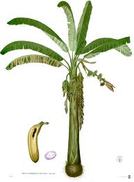MUSA PARADIASICA
description & usage
This plant is cultivated in tropical and sub-tropical countries for nutritious and delicious fruit. It is well known plant to all.
Uses:
The root is used for glandular diseases, VD, anaemia, diarrhoea. The pseudo stem is mainly for ulcer, cholera, jaundice ,wounds and cuts, asthma, piles and kidney stone. The leaves for eye diseases. wounds and cuts, cool dressing for headache. The flowers checks excessive bleeding during mensturation, diabetes, earache. The fruit spitting of blood. diarrhoea, indigestion and accumulation of acid in the body. Cures scurvy and protects the alimentary tract.
How to Use:
Ripened fruit is also used as a vegetable. Juice of the fruit is sometimes made into a fermented liquor, which is given in atonic dyspepsia. A plantain well washed may be given mixed with four ounces of milk, three times a day in cases of sprue, diarrhoea and scurvy. Raw plantains are also made into a soup for the some purpose. When used for children, sugar or sugar-candy, instead of salt, may be used. Older and greener leaves make an excellent eye-shade in eye diseases. Juice of the flowers mixed with curd is administered in dysmenorrgoea and menorrhagia.
Cooked flowers are used in diabetes. Juice of the bark and leaf is given to children suffering from an over dose of opium ; One ounce with one ounce of ghee is a brisk purgative . A. cold infusion of the root is recommended for venereal diseases, anaemia and disorders of the blood. The ash of the plant is useful for ulcers. The stem juice is used for cholera, nervous disorders, diarrhoea, jaundice, dysentery, cuts and wounds to check bleeding.
Parts Used:
Leaf, flower, plantain, fruit,
Taste:
Astringency, sweetness
Action:
Astringent, styptic, diuretic, demulcent, laxative, nutritive
Uses:
The root is used for glandular diseases, VD, anaemia, diarrhoea. The pseudo stem is mainly for ulcer, cholera, jaundice ,wounds and cuts, asthma, piles and kidney stone. The leaves for eye diseases. wounds and cuts, cool dressing for headache. The flowers checks excessive bleeding during mensturation, diabetes, earache. The fruit spitting of blood. diarrhoea, indigestion and accumulation of acid in the body. Cures scurvy and protects the alimentary tract.
How to Use:
Ripened fruit is also used as a vegetable. Juice of the fruit is sometimes made into a fermented liquor, which is given in atonic dyspepsia. A plantain well washed may be given mixed with four ounces of milk, three times a day in cases of sprue, diarrhoea and scurvy. Raw plantains are also made into a soup for the some purpose. When used for children, sugar or sugar-candy, instead of salt, may be used. Older and greener leaves make an excellent eye-shade in eye diseases. Juice of the flowers mixed with curd is administered in dysmenorrgoea and menorrhagia.
Cooked flowers are used in diabetes. Juice of the bark and leaf is given to children suffering from an over dose of opium ; One ounce with one ounce of ghee is a brisk purgative . A. cold infusion of the root is recommended for venereal diseases, anaemia and disorders of the blood. The ash of the plant is useful for ulcers. The stem juice is used for cholera, nervous disorders, diarrhoea, jaundice, dysentery, cuts and wounds to check bleeding.
Parts Used:
Leaf, flower, plantain, fruit,
Taste:
Astringency, sweetness
Action:
Astringent, styptic, diuretic, demulcent, laxative, nutritive


